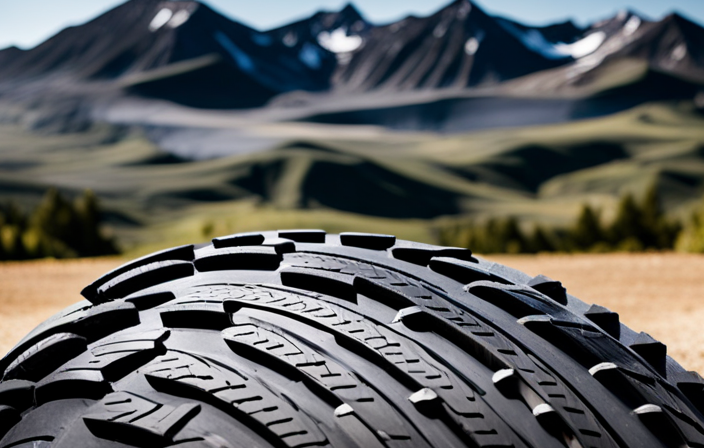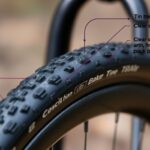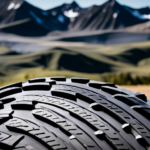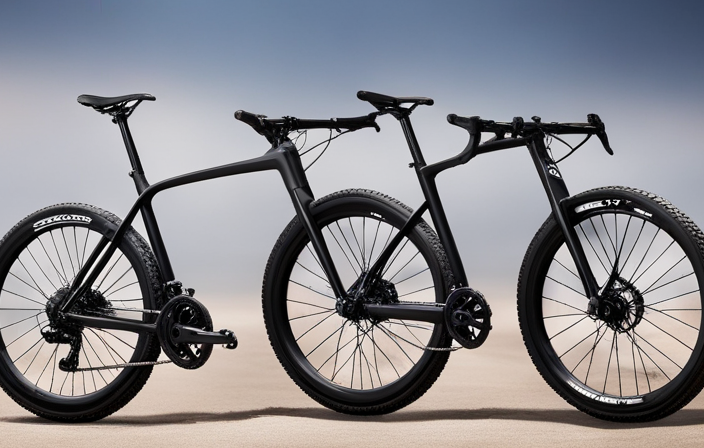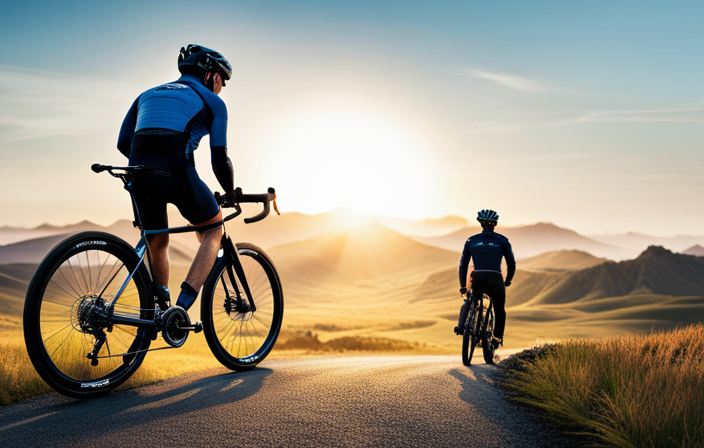Imagine riding your bike down a gravel path, experiencing the excitement of the wind hitting your face and the sound of pebbles crunching under your tires.
Now imagine that experience even smoother, faster, and puncture-free. That’s exactly what tubeless tires can do for your gravel bike.
By eliminating tubes and offering increased puncture resistance, lower tire pressure, and enhanced traction, tubeless tires provide an overall better performance on gravel terrain.
In this article, I will delve into why switching to tubeless tires is a game-changer for any avid gravel cyclist.
Key Takeaways
- Improved puncture resistance and elimination of pinch flats
- Enhanced traction, control, and stability on varied surfaces
- Smoother ride and increased comfort on rough terrain
- Quick and convenient solution for repairing flats on the go
Understanding Tubeless Tires
Understanding tubeless tires is crucial when considering the switch on a gravel bike. Tubeless tires have gained popularity in recent years due to their numerous advantages over traditional tubed tires. One of the main advantages is improved puncture resistance. Unlike tubed tires, which are more susceptible to flats and punctures, tubeless tires provide an extra layer of protection against sharp objects on rough terrain. The absence of an inner tube also eliminates pinch flats caused by the tube getting pinched between the tire and rim during hard impacts.
In addition to improved puncture resistance, tubeless tires offer better traction and control on varied surfaces. By allowing riders to run lower tire pressures without worrying about pinch flats, tubeless setups enhance grip and increase comfort on gravel roads. Moreover, this setup provides a smoother ride as it absorbs small bumps and vibrations more effectively.
Despite these advantages, there are some disadvantages associated with tubeless tires. They require careful installation and maintenance, as any mistakes could cause air leaks or burping during rides. Additionally, sealant needs to be regularly replenished to ensure proper sealing against punctures.
Overall, understanding the advantages and disadvantages of tubeless tires is essential when considering their switch on a gravel bike. With improved puncture resistance being one of its key benefits, let’s now explore how this upgrade can enhance your riding experience even further.
Improved Puncture Resistance
With tubeless tires, you’ll experience fewer flats and punctures on your gravel adventure. Tubeless tires offer improved durability and enhanced off-road capability, making them a great choice for any gravel bike rider looking to minimize the risk of tire damage.
Here are some reasons why tubeless tires provide superior puncture resistance:
- Sealing Technology: Tubeless tires use sealant that fills punctures instantly, preventing air from escaping and maintaining tire pressure.
- No Tubes Means No Pinch Flats: With no inner tubes to pinch against the rim, tubeless tires eliminate the risk of pinch flats that occur when riding over rough terrain or hitting sharp edges.
- Stronger Sidewalls: Tubeless tires often have reinforced sidewalls, which add extra strength and protection against cuts and slashes from rocks or other trail hazards.
- Thicker Tread: The tread on tubeless tires is typically thicker than traditional clincher tires, providing an additional layer of defense against punctures.
- Enhanced Rim Compatibility: Tubeless rims have a different design that allows for better integration with the tire bead, creating a tighter seal and minimizing the chance of air leakage.
By switching to tubeless tires, you can enjoy improved durability and enhanced off-road capability during your gravel adventures. Not only will you experience fewer flat tires and punctures but also have greater control over lower tire pressures for a smoother ride.
Lower Tire Pressure for a Smoother Ride
Lowering tire pressure can result in a smoother ride on rough terrain. By running tubeless tires at lower pressures, you can increase stability and improve cornering on gravel surfaces. When the tire pressure is reduced, the larger contact patch between the tire and the ground allows for better grip and control.
To illustrate this concept, let’s consider a comparison between two scenarios: riding with high tire pressure versus low tire pressure. In the table below, we can see how different pressures affect various aspects of performance:
| Tire Pressure | Stability | Cornering |
|---|---|---|
| High | Decreased | Decreased |
| Low | Increased | Increased |
As demonstrated, lowering the tire pressure enhances both stability and cornering capabilities. This is especially crucial when navigating uneven terrain where maintaining control is essential.
By achieving increased stability and improved cornering through lower tire pressures, riders can enjoy a smoother ride on gravel roads. This translates to enhanced traction and control on challenging terrains. The subsequent section will delve into another benefit of switching to tubeless tires – increased traction and control on gravel terrain – further highlighting why it’s advantageous to make this switch.
Note: To view this markdown table properly, please ensure that your text editor or viewer supports markdown formatting.
Increased Traction and Control on Gravel Terrain
To improve your grip and handling on rough gravel surfaces, you’ll experience increased traction and control. Tubeless tires provide a significant advantage in this aspect, as they allow for lower tire pressures without the risk of pinch flats. By running tubeless tires on your gravel bike, you can achieve increased stability and improved cornering performance.
The key to the enhanced traction and control offered by tubeless tires lies in their ability to conform to the terrain. With no inner tubes, these tires can be run at lower pressures compared to traditional clincher setups. This increased surface area contact with the ground allows for better grip, especially on loose or uneven surfaces. You’ll notice a marked improvement in your ability to maintain control over your bike while navigating challenging gravel terrains.
Furthermore, tubeless tires offer improved cornering capabilities due to their enhanced stability. The absence of inner tubes eliminates any potential for pinch flats caused by hitting sharp edges or objects on the road. This means that you can confidently take corners at higher speeds, knowing that your tires will maintain their shape and grip throughout the maneuver.
By switching to tubeless tires on your gravel bike, not only will you experience increased traction and control but also eliminate the worry of pinch flats. This next section will delve into how tubeless technology prevents such punctures from occurring.
Elimination of Pinch Flats
You can eliminate the worry of pinch flats by utilizing tubeless technology on your gravel bike. Tubeless tires offer several benefits that make them advantageous for off-road riding.
One of the main advantages is their ability to resist pinch flats, also known as snake bites. Pinch flats occur when the inner tube gets pinched between the tire and a hard object, causing it to puncture. With tubeless tires, there is no inner tube to pinch, as they rely on an airtight seal between the tire and rim. This eliminates the risk of pinch flats and allows you to ride with peace of mind.
In addition to preventing pinch flats, tubeless tires offer other advantages on gravel terrain. They provide enhanced traction and control due to their ability to run at lower pressures without sacrificing performance. The absence of an inner tube also allows for more flexibility in tire selection, as you can experiment with different widths and treads to find the optimal setup for your riding style.
By switching to tubeless tires on your gravel bike, you not only eliminate the concern of pinch flats but also gain increased traction and control on challenging gravel surfaces. This leads us into our next topic: enhanced rolling efficiency, which further enhances your riding experience.
Enhanced Rolling Efficiency
One major benefit of utilizing tubeless technology on your gravel bike is the enhanced rolling efficiency it provides. With tubeless tires, you can experience increased speed and improved handling on various terrains. The absence of an inner tube reduces friction between the tire and the road surface, resulting in a smoother ride and better overall performance.
Tubeless tires offer lower rolling resistance compared to traditional clincher tires with tubes. This means that less energy is wasted as the tires roll, allowing you to maintain a higher average speed on gravel roads or other uneven surfaces. The reduced friction also contributes to improved handling, giving you more control over your bike when navigating corners or challenging terrain.
Additionally, by eliminating the need for tubes, tubeless tires allow for lower tire pressure without sacrificing performance. This ability to run lower tire pressure provides better comfort by absorbing more vibrations from rough surfaces. It also increases traction and grip, especially when cornering or riding off-road.
By enhancing rolling efficiency through decreased friction and improved handling capabilities, tubeless tires are a valuable upgrade for any gravel cyclist looking to maximize their speed and control on diverse terrains.
Ability to Run Lower Tire Pressure for Better Comfort
Lowering your tire pressure with tubeless technology provides a more comfortable ride on rough terrain. By allowing you to run lower tire pressures, tubeless tires enhance the handling capabilities of your gravel bike. When riding on uneven surfaces, such as gravel or dirt trails, lower tire pressure improves traction and stability. This is especially important when navigating corners or descending steep slopes.
In addition to improved handling, running lower tire pressure also reduces vibrations for a more comfortable ride. With traditional clincher tires, higher pressures are needed to prevent pinch flats. However, this can result in a harsh and jarring experience when encountering bumps or obstacles. Tubeless tires eliminate the risk of pinch flats and allow you to significantly decrease tire pressure without compromising performance.
Lower pressures absorb impacts better, providing a smoother and more controlled ride over rough surfaces. The reduced vibrations not only increase comfort but also minimize fatigue during long rides. Whether you’re tackling challenging off-road sections or enjoying a leisurely gravel ride, the ability to run lower tire pressures enhances your overall experience.
Transitioning into the subsequent section about ‘sealant for instant flat repair’, it’s worth noting that tubeless tires also offer another advantage – the ability to seal punctures instantly with sealant instead of having to stop and change tubes like with traditional clincher setups.
Sealant for Instant Flat Repair
Using sealant provides a quick and convenient solution for repairing flats on the go. The effectiveness of sealant in sealing punctures is highly beneficial for gravel bike riders. When a puncture occurs, the sealant instantly reacts with the air to form a flexible plug that seals the hole. This allows riders to continue their journey without any significant delay or inconvenience.
To illustrate the benefits of using sealant, consider the following comparison table:
| Sealant Effectiveness | Alternative Repair Options | Ease of Use |
|---|---|---|
| Provides instant flat repair | Requires carrying spare tubes or patch kits | Quick and easy application |
| Seals punctures up to a certain size | May require removal of tire and tube for repair | No need to remove tire or tube |
| Works effectively even on rough terrain | Limited effectiveness on challenging surfaces | Suitable for all types of gravel riding |
As evidenced by this table, using sealant offers numerous advantages over alternative repair options. Its ability to provide instant flat repair without needing to carry spare tubes or patch kits makes it an ideal choice for gravel bike riders. Furthermore, sealant can effectively seal punctures even on rough terrains, ensuring a hassle-free riding experience.
With its proven effectiveness, using sealant is just one part of the easy installation process that makes switching to tubeless tires on a gravel bike worthwhile.
Easy Installation Process
To make the installation process easier, you can follow these step-by-step instructions for installing sealant on your tires:
-
Start by deflating the tire completely and removing the valve core using a valve core tool.
-
Shake the sealant bottle vigorously to ensure it is well-mixed before pouring it into the tire through the valve stem.
-
Use a floor pump or an air compressor to inflate the tire to its recommended pressure. This will help distribute the sealant evenly inside.
-
Spin the wheel slowly in order to coat the entire inner surface of the tire with sealant.
When it comes to installation tips, it’s important to remember that different brands of tubeless tires may have slight variations in their installation processes. However, some popular and highly recommended tire brands for gravel bikes include Maxxis, Schwalbe, Continental, and WTB.
By following these installation tips and choosing one of these trusted tire brands, you can ensure a smooth and hassle-free experience when setting up your tubeless tires on your gravel bike.
Now let’s move on to discussing compatibility with a wide range of gravel bike rims…
Compatibility with a Wide Range of Gravel Bike Rims
When installing sealant on your tires, it is important to consider the compatibility with a wide range of rims commonly found on gravel bikes. Tubeless tire benefits include increased traction, reduced rolling resistance, and improved puncture resistance. However, before making the switch to tubeless tires on your gravel bike, there are some considerations to keep in mind.
One of the key advantages of tubeless tires is their compatibility with a wide range of gravel bike rims. Whether you have carbon or aluminum rims, tubeless tires can be easily mounted on them without any additional modifications. This means that you don’t have to worry about finding specific rims for your tubeless setup.
In addition to being compatible with different types of rims, tubeless tires also offer flexibility in terms of tire size options. You can choose from a variety of widths and tread patterns to suit your riding style and terrain preferences. This allows you to customize your gravel bike setup for optimal performance and comfort.
By switching to tubeless tires that are compatible with a wide range of gravel bike rims, you can experience the many benefits they offer while enjoying cost savings in the long run. With fewer flats and lower maintenance requirements, you’ll spend less time and money on repairs and replacements, allowing you to fully enjoy your rides without worrying about unexpected expenses.
Cost Savings in the Long Run
Save money in the long run by opting for tubeless tires compatible with a wide range of rims commonly found on your gravel bike. Tubeless tires offer cost effectiveness and long-term savings compared to traditional tubed tires. Here are three reasons why:
-
Reduced punctures: Tubeless tires use a sealant that fills small punctures, preventing air leakage and reducing the need for frequent repairs or replacements. This means fewer trips to the bike shop and less money spent on new inner tubes.
-
Extended tire lifespan: With tubeless tires, you can run lower pressures without worrying about pinch flats caused by tubes. This not only improves ride comfort but also reduces wear and tear on the tire itself, leading to a longer lifespan compared to tubed tires.
-
Lower maintenance costs: Tubeless systems require less maintenance overall. Without tubes, there is no need to constantly check and replace them when they wear out or get damaged. Additionally, tubeless setups often eliminate rim tapes, reducing the chances of tape failure or replacement.
By choosing tubeless tires for your gravel bike, you can enjoy these cost-saving benefits in the long term while still maintaining optimal performance on different terrains. Plus, reduced rotational weight from going tubeless allows for faster acceleration, as we will explore in the next section about ‘reduced rotational weight for faster acceleration’.
Reduced Rotational Weight for Faster Acceleration
Experience faster acceleration on your gravel bike by reducing the rotational weight with tubeless tires. By opting for tubeless tires, you can significantly reduce rolling resistance and improve maneuverability, resulting in a more efficient riding experience.
One of the main advantages of tubeless tires is their ability to reduce rolling resistance. With traditional tubed tires, the friction between the tire and inner tube can contribute to energy loss, slowing down your acceleration. However, by eliminating the need for an inner tube, tubeless tires minimize this friction and allow for a smoother ride with reduced rolling resistance. This means that you can put more power into each pedal stroke and experience quicker acceleration on various terrains.
Additionally, switching to tubeless tires reduces rotational weight on your gravel bike. Rotational weight refers to any weight that is spinning while you ride – including the wheels and tires. By reducing this weight, you’ll notice improved responsiveness when accelerating or changing direction. The lighter rotational weight allows for easier maneuverability through tight turns or technical sections of the trail.
In conclusion, by choosing tubeless tires for your gravel bike, not only will you benefit from reduced rolling resistance but also enjoy faster acceleration due to decreased rotational weight. Next up: discover how going tubeless eliminates the hassle of carrying or replacing tubes on your rides.
No More Tubes to Carry or Replace
Say goodbye to the hassle of carrying or replacing tubes with tubeless tires. Switching to tubeless tires not only eliminates the need for tubes, but it also offers a lighter load for your gravel bike. With no tubes to carry, you can say goodbye to the extra weight and enjoy a more efficient ride.
Tubeless tires are designed to seal themselves when punctured, thanks to a special sealant inside. This means that you won’t have to worry about carrying spare tubes or repairing flats on the go. The sealant fills any holes or cuts in the tire as soon as they occur, keeping you rolling without interruption.
Not having tubes also reduces rotational weight, which leads to faster acceleration and improved performance on gravel terrain. By eliminating the inner tube, you’re shedding unnecessary weight from your bike, allowing you to accelerate quicker and maintain speed more easily.
Furthermore, tubeless tires offer increased protection against rim damage compared to traditional tubed setups. The absence of an inner tube reduces the chance of pinch flats and rim damage caused by impact with sharp objects or potholes. This ensures a smoother ride and less downtime due to repairs.
With no tubes hassle and a lighter load, switching to tubeless tires is a game-changer for gravel biking. It’s time to explore how reduced chance of rim damage further enhances your riding experience.
Reduced Chance of Rim Damage
You’ll notice a significant decrease in the risk of damaging your rims when riding with tubeless tires. Tubeless technology provides excellent rim protection and durability benefits that can greatly enhance your gravel biking experience.
Unlike traditional tubed tires, which are more prone to pinch flats and punctures, tubeless tires have an airtight seal between the tire and rim. This seal prevents any sudden loss of air pressure, reducing the chance of hitting obstacles with excessive force and potentially damaging your rims.
The absence of tubes also means that there is no need to worry about pinch flats caused by inadequate tire pressure or sharp impacts. With tubeless tires, you can run lower pressures for better traction without sacrificing durability or risking damage to your rims. The tire itself acts as an additional buffer against impacts, absorbing shocks from rough terrain and providing added protection to the rim.
By reducing the risk of rim damage, tubeless tires contribute to an overall better performance on gravel roads. The enhanced durability allows riders to confidently tackle challenging terrain without constantly worrying about potential flat tires or costly repairs. With improved rim protection provided by tubeless technology, you can focus on enjoying your ride and pushing yourself further on gravel adventures.
Transitioning into the subsequent section about ‘overall better performance on gravel roads’, riders can expect not only increased rim protection but also improved traction and reduced rolling resistance with tubeless tires.
Overall Better Performance on Gravel Roads
Improved performance on gravel roads can be achieved with tubeless tires. They provide enhanced traction and reduced rolling resistance. One of the key benefits of tubeless tires is their increased durability compared to traditional clincher tires. They are less likely to suffer from flats caused by sharp rocks or debris on gravel roads. This increased durability allows riders to confidently tackle rough terrains without the fear of sudden tire failure.
In addition to increased durability, tubeless tires also offer improved stability on gravel roads. The absence of an inner tube allows for lower tire pressures. This increases the contact patch between the tire and the road surface. The larger contact patch provides better grip and traction, especially when cornering or climbing steep inclines on loose gravel surfaces.
Furthermore, the reduced rolling resistance of tubeless tires contributes to their overall better performance on gravel roads. By eliminating the friction between the inner tube and tire casing, tubeless tires roll more smoothly and efficiently. This translates into less effort required from the rider to maintain speed and momentum, allowing for a more enjoyable riding experience.
In conclusion, switching to tubeless tires on a gravel bike offers increased durability and improved stability compared to traditional clincher tires. Their enhanced traction and reduced rolling resistance make them a valuable upgrade for any rider looking to optimize their performance on gravel roads.
Frequently Asked Questions
Do tubeless tires require special rims or can they be used with any gravel bike rims?
Tubeless tires can be used with any gravel bike rims, but it’s recommended to use tubeless-ready rims for optimal performance.
Tubeless tire benefits include improved traction and control on gravel roads due to the ability to run lower tire pressures without the risk of pinch flats. This enhances comfort and reduces rolling resistance.
Additionally, tubeless tires offer better puncture protection as they seal themselves when pierced by thorns or sharp objects on the road.
How often should sealant be checked and replaced in tubeless tires?
Regularly checking and replacing sealant in tubeless tires is crucial for optimal performance. Think of it as the lifeblood of your tire, ensuring airtightness and puncture protection.
I recommend inspecting the sealant every 2-3 months, or more frequently if you ride in harsh conditions. Replacing the sealant annually is generally sufficient.
Tubeless tires offer numerous benefits for gravel biking, including improved traction, lower rolling resistance, and reduced risk of flats.
Can tubeless tires be used in all weather conditions, including wet and muddy terrain?
Tubeless tires offer several advantages. One of these advantages is improved performance in wet and muddy terrain. The absence of an inner tube eliminates the risk of pinch flats, providing a more reliable and puncture-resistant ride. Additionally, with lower tire pressures, tubeless tires can conform to the ground better, increasing traction on slippery surfaces. Another benefit is that the sealant inside the tire helps to seal small punctures on-the-go, ensuring continued performance even in challenging weather conditions.
Are tubeless tires more expensive than traditional tires and tubes?
Tubeless tires are generally more expensive than traditional tires and tubes. However, they offer several advantages that justify the higher cost.
Tubeless tires are known for being more puncture resistant than traditional tires, thanks to their ability to seal punctures on their own. Additionally, converting traditional tires to tubeless is a relatively straightforward process that can be done using special rim tape and sealant.
Do tubeless tires require any special maintenance or care compared to traditional tires?
Maintaining tubeless tires is straightforward as long as you follow a few guidelines. After installation, regularly check tire pressure using a gauge and inflate as needed to ensure optimal performance on gravel roads.
Additionally, inspect the sealant every few months and add more if necessary to prevent air leakage. Remember, ‘an ounce of prevention is worth a pound of cure’ when it comes to tubeless tire maintenance.
The benefits of tubeless tires on gravel include reduced risk of punctures and enhanced traction.
Conclusion
In conclusion, switching to tubeless tires on my gravel bike has been a game-changer. The improved puncture resistance and elimination of pinch flats have saved me countless frustrating moments on the road.
Not to mention, the lower tire pressure has provided a smoother ride that feels like floating on clouds. With increased traction and control on gravel terrain, I feel like a superhero navigating through any obstacle.
Plus, the reduced rotational weight has given me lightning-fast acceleration. It’s safe to say that tubeless tires have taken my gravel biking experience to new heights!

